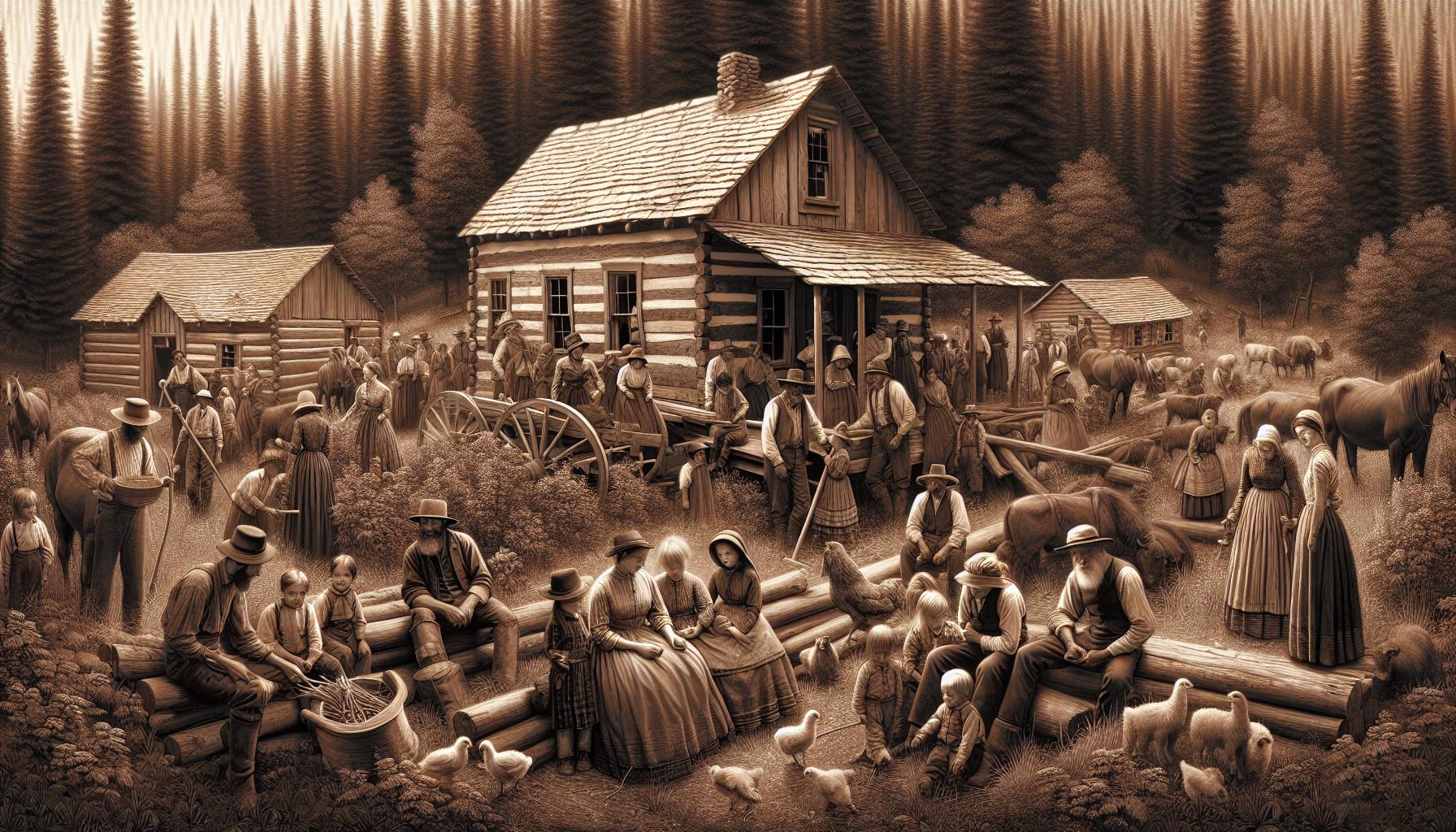When I think about the early settlers in Redmond, I’m reminded of their incredible pioneer spirit. These were folks who ventured into the unknown, driven by dreams of a better life and the promise of untamed land. They faced countless challenges, from harsh weather to rugged terrain, yet their determination never wavered.
Imagine arriving in a place with no roads, no stores, and no modern conveniences. It’s hard to fathom, but these early settlers built their homes, communities, and livelihoods from scratch. Their stories of resilience and ingenuity continue to inspire us today, reminding us of the strength it takes to carve out a new beginning.
Historical Context
Early Redmond was shaped by a vibrant blend of opportunity and hardship. Settlers were drawn by the promise of fertile land, logging prospects, and the dream of a new beginning.
The Beginnings of Redmond
In the late 1800s, Redmond began to form as a small community in Washington state. The area, rich in natural resources, attracted settlers looking for timber and arable land. The Sammamish River, providing access to Lake Washington, was a strategic advantage for transportation and trade. As more families arrived, they established essential infrastructure—schools, churches, and businesses—laying the foundation for what would become a thriving town. Despite facing daily challenges, these early inhabitants exhibited remarkable determination and collaborative spirit.
Key Events Leading to Settlement
Several pivotal events contributed to the settlement of Redmond. The completion of the Seattle, Lake Shore & Eastern Railway in 1888 transformed the area, making it accessible and attractive for settlers and businesses. The arrival of the first post office in 1889 signified growing stability and connection to broader societal networks. In 1912, Redmond officially incorporated as a city, marking a significant milestone in its development. Throughout these formative years, logging and agriculture remained the primary economic activities, driving both population growth and community evolution.
The Pioneers
The early settlers of Redmond embodied perseverance and fortitude. These pioneers tackled immense challenges, building the foundations of a community that thrives today.
Prominent Early Settlers
Hugh Stevenson was one of Redmond’s first settlers, arriving in 1871. Known for his resilience, he built the area’s first homestead. His contributions set the stage for others to follow.
Luke McRedmond, another notable figure, arrived in 1870. He played a crucial role in establishing the town, which would later bear his name. McRedmond filed the town’s first post office request, pivotal for communication and trade.
Edward P. Cadman, who arrived in 1872, was vital in Redmond’s development. He established a sawmill, enabling the construction of homes, businesses, and infrastructure. His entrepreneurial spirit greatly impacted Redmond’s growth.
George W. Ames arrived in 1886, significantly contributing to the town’s agricultural sector. His farming innovations helped support the local economy and provided food security for the growing community.
Notable Contributions and Achievements
These pioneers accomplished remarkable feats. Hugh Stevenson, besides building the first homestead, contributed to early transportation networks, facilitating movement and trade within the region.
Luke McRedmond, known for his leadership, was instrumental in securing Redmond’s first post office in 1889. This achievement connected Redmond to broader markets and advanced its economic prospects.
Edward P. Cadman made a lasting impact with his sawmill, driving Redmond’s logging industry and supporting vital infrastructure projects. His sawmill became a cornerstone of local development, creating jobs and stimulating economic growth.
George W. Ames’s agricultural contributions revolutionized local farming practices. His innovative techniques increased crop yields, ensuring sustenance for settlers and creating surplus for trade.
These early settlers shaped Redmond’s history through their determination and vision. Their legacies endure in the town’s thriving, resilient community.
Daily Life of Early Settlers
The daily lives of Redmond’s early settlers were marked by hard work and a strong sense of community. Their days were filled with tasks essential for survival and building a thriving town.
Living Conditions
Living conditions for early settlers in Redmond were challenging. They built their homes using local timber, creating simple, one-room cabins until they could expand. Without electricity or running water, families relied on candles and lanterns for light. They drew water from nearby streams or wells. Heating came from wood-burning stoves, which also served as cooking appliances.
Settlers grew vegetables and raised livestock for food, supplementing their diets with hunting and fishing. Gardens provided potatoes, beans, and corn, while chickens, cows, and pigs supplied eggs, dairy, and meat. Echoing their pioneering spirit, settlers preserved food through smoking, salting, and canning to endure the harsh winters.
Basic furniture, often handmade, included wooden beds, tables, and chairs. Quilts and woven blankets added comfort and warmth. Their clothing, made from wool and cotton, was practical and durable, designed to withstand hard labor.
Community and Social Activities
Despite their demanding work, early settlers valued community and social activities. Church gatherings, the centerpiece of social life, occurred every Sunday. These meetings provided spiritual support and opportunities to socialize.
Neighbors often came together for barn raisings, harvesting, and quilting bees. These events combined productivity with socializing. They shared stories, exchanged news, and helped each other in times of need.
Festivals and fairs celebrated harvests and holidays, featuring games, food, and music. Children played with homemade toys, like wooden dolls and marbles, and participated in group games such as tag and hide-and-seek.
The community’s cooperative spirit extended to educational activities. They established schools where children learned reading, writing, and arithmetic, with parents often contributing as teachers. Libraries, albeit small and sparse, offered books that settlers shared and cherished. These activities fostered a sense of belonging and cooperation, fundamental to the town’s growth.
Challenges and Hardships
Early settlers in Redmond faced a range of significant challenges that tested their resilience and determination. From environmental obstacles to social dynamics, these pioneers navigated a path full of hardships that shaped their community’s character.
Environmental Obstacles
Settlers contended with dense forests and marshy landscapes that made land cultivation difficult. Clearing trees and stumps was backbreaking work. The abundant rainfall, while beneficial, often led to flooding. Crops were at risk, and travel became treacherous on muddy roads. Winters posed additional difficulties with cold temperatures and heavy snowfall. These conditions strained their resources. Many relied on wood-burning stoves for heat and cooking, cutting and storing wood a constant task. Hunting and gathering supplemented limited food supplies. Vegetables provided sustenance when harvests were successful.
Diseases like malaria and smallpox affected their health. Access to medical supplies and trained professionals was limited. Many turned to home remedies and neighborly support for care. Despite these environmental challenges, the settlers displayed remarkable ingenuity. They built raised houses to avoid flooding, created drainage systems, and harnessed natural resources efficiently.
Conflict and Cooperation
The diverse mix of settlers in Redmond often led to conflicts over land and resources. Disagreements arose among neighbors about property boundaries and water rights. Tensions could escalate quickly without legal systems in place. However, cooperation frequently outweighed conflict. Community members understood their interdependence. They helped each other with large tasks like barn raising and crop harvesting. Social gatherings, like church events, provided opportunities for reconciliation and bonding.
Building essential infrastructure required collective effort. Schools, churches, and roads were community projects. These shared endeavors strengthened relationships and fostered a sense of unity. Cooperation also extended to interactions with Native American tribes. Although tensions existed, trade and knowledge exchange occurred, showing mutual respect. Settlers learned local agricultural techniques, benefiting from indigenous expertise. Pioneers balanced conflict with cooperation, navigating social dynamics to build a cohesive community.
Lasting Impact
The pioneering spirit of Redmond’s early settlers continues to shape the city today, leaving a rich legacy in various aspects of community life.
Cultural Heritage
Redmond’s cultural heritage is deeply rooted in the traditions and customs established by its early settlers. Annual events like the Redmond Derby Days, which began as a simple celebration in 1939, highlight the community’s long-standing love for festivals and gatherings. The Redmond Historical Society preserves artifacts and documents, providing insight into those formative years. Educational programs in schools teach children about their town’s history, ensuring the stories of early settlers like Luke McRedmond and Hugh Stevenson remain alive. Today, the Mathew House Museum, located in the heart of Redmond, stands as a testament to the architectural styles and daily lives of the 19th-century settlers. Community quilting bees and seasonal farmers’ markets also continue as modern extensions of the cooperative spirit that defined early life in Redmond.
Modern-Day Redmond
Modern-day Redmond is a blend of historical charm and technological innovation, reflecting the lasting impact of its early settlers. With a population of over 70,000, Redmond has become a tech hub, hosting the headquarters of Microsoft and other major tech firms. The city maintains strong ties to its past, with landmarks like the Odd Fellows Hall and the Historic Redmond Courthouse still standing. The parks and trails, such as the Sammamish River Trail, celebrate the natural landscapes that early settlers relied on for sustenance and transportation. Innovative urban planning has focused on sustainability, drawing inspiration from the settlers’ resourcefulness. Community events, like the Redmond Lights Festival, bridge the gap between the town’s rich history and its modern aspirations, showcasing the enduring community spirit that defines Redmond.
Conclusion
The pioneering spirit of Redmond’s early settlers is truly inspiring. Their determination and resilience laid a strong foundation for the vibrant community we see today. From overcoming harsh conditions to building essential infrastructure, their efforts have left a lasting legacy.
As I walk through Redmond, I can’t help but feel a deep appreciation for these early trailblazers. Their blend of hard work, cooperation, and innovation continues to influence our town’s growth and character. It’s a testament to their enduring spirit that Redmond remains a place of both historical charm and modern innovation.





0 Comments